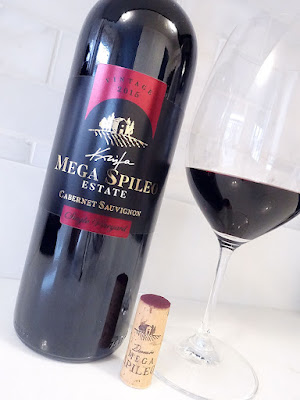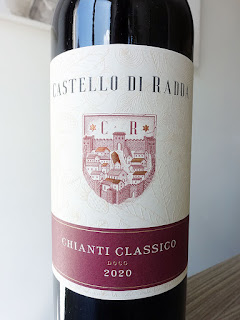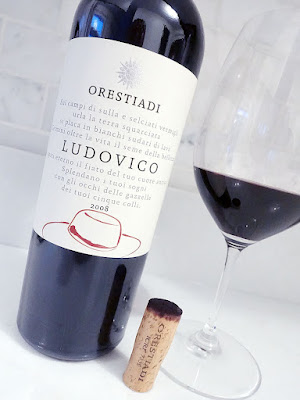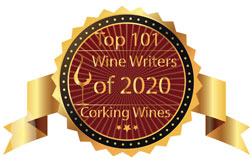red wine review is an excellent, single vineyard Cabernet Sauvignon from Greece that landed at the LCBO on the weekend as part of the LCBO VINTAGES New Release Collection.
It is produced by Mega Spileo Estate, an historic and significant monastery and winery situated near the town of Kalavryta, within the Achaea region of the Peloponnese in Southern Greece. Mega Spileo is intrinsically bound to one of the most significant religious monuments and reference points in Greek history, as it is the oldest continuously occupied institution in Greece and the 2nd oldest in the world. The estate is built inside a large cave overlooking the Vouraikos Gorge and provides stunning, natural surroundings.
The Monastery was established in 362 A.D. by brothers and monks Symeon and Theodore, after they discovered a Holy icon of the Virgin Mary made of mastic and wax deep within the cliffside cave. The monastery has functioned continuously ever since and is a beacon of Greek Orthodoxy despite the major destruction it suffered from several fires, the last of which was lit by German occupation forces in 1934. Miraculously, the Holy Icon has survived through all these disasters untouched.
Mega Spileo Estate owns 4 vineyards, but the first was The Great Vineyard, which was also a dependency of the monastery. From the mid-15th century onwards, the monks grew grapes on the Great Vineyard and produced wine for the Holy Communion and as a nutritious dietary supplement. The monks built a wine press, sleeping quarters, and chapel on the estate, and produced wine for themselves, visitors to the monastery, and for inhabitants of the wider region. The grapes were harvested and pressed in the vineyard, then the juice was transported by mule to the monastery where it would be stored in barrels in the cellar. It was during this time that the Monastery acquired two massive barrels and named them "Angelis" and "Stamatis", in honour of the coopers who made them. Each of these barrels could store 12 tonnes of wine. Unfortunately, Stamatis was destroyed in one of the great fires, while Angelis survives to the present day, along with some other smaller barrels.
During the period of Turkish rule, the Monastery was protected because Sultan Mehmed had promulgated a decree to protect it. When the Greek War of Independence broke out in 1821, resistance fighters sought refuge at the Monastery, where they could find money, bread, cheese and wine. The Mega Spileo Monastery played a crucial role throughout the war as it bolstered the faith and heroic efforts of the Greeks. Up until 1870, the monk population exceeded 200 people, while demand for foodstuffs and wine increased dramatically. Around 1930, the number of monks decreased dramatically, which meant that there were fewer hands to cultivate grapes, which led to reduced production of wine. By the mid-1950s, the Estate was completely abandoned because there were so few monks to tend to the grapes.
Today, Mega Spileo is guided by brothers Giannis & Theodoros Anastasiou. This new chapter began in 1999, when the Anastasiou brothers received a long-term lease on the Estate from the Monastery. The Anastasiou brothers are guided by their vision to revitalize the historical vineyard using a team of experienced wine producers and oenologists who re-planted vines and implemented best practices, including sustainable agriculture and environmental protection, for the cultivation and production of high-quality wine to create a completely new and unique Estate - The Mega Spileo Estate. Cultivating both local and international varieties, Mega Spileo produces top-quality products that have become a significant point of reference for Greek wine production.
This red wine is crafted using 100% Cabernet Sauvignon that was organically cultivated at their Mega Spileo Estate. It is from 3 hectares of vines at their Great Vineyard, situated at 820 metres above sea level and planted on clay, sand and pebble soil. After harvesting the grapes in mid-October, the grapes were pressed and remained in tanks until fermentation was completed. The wine was then transferred into French oak barrels to undergo malolactic fermentation, followed by maturation in barrels for at least 2 years. It was then bottled and spent 2 years in bottle for further maturation. To preserve its natural character, the wine did not undergo stabilization and filtering. Let's see how this 2015 Cabernet Sauvignon from Greece is tasting tonight...
The medium-high to highly aromatic nose is intense and a touch funky brett off the top, revealing complex and maturing dark berry, black currant, dried herbs, and Asian spice aromas with hints of cassis, dried berry, savoury earth, and oak spice. On the dry, full-bodied palate it offers spicy and maturing dark berry, black currant, cassis, dried herbs, and spice flavours which are supported by fresh acidity. It's firmly structured with dusty textured and drying tannins. Dark berry notes give way to savoury earth flavours on the long, dry finish. Highly recommended buy! Score: 92 pts
Limited availability of other lovely wines by Mega Spileo Estate can be found at the LCBO, while the entire range can be ordered through their Agent - Kolonaki Fine Wines & Spirits.
It is produced by Mega Spileo Estate, an historic and significant monastery and winery situated near the town of Kalavryta, within the Achaea region of the Peloponnese in Southern Greece. Mega Spileo is intrinsically bound to one of the most significant religious monuments and reference points in Greek history, as it is the oldest continuously occupied institution in Greece and the 2nd oldest in the world. The estate is built inside a large cave overlooking the Vouraikos Gorge and provides stunning, natural surroundings.
The Monastery was established in 362 A.D. by brothers and monks Symeon and Theodore, after they discovered a Holy icon of the Virgin Mary made of mastic and wax deep within the cliffside cave. The monastery has functioned continuously ever since and is a beacon of Greek Orthodoxy despite the major destruction it suffered from several fires, the last of which was lit by German occupation forces in 1934. Miraculously, the Holy Icon has survived through all these disasters untouched.
Mega Spileo Estate owns 4 vineyards, but the first was The Great Vineyard, which was also a dependency of the monastery. From the mid-15th century onwards, the monks grew grapes on the Great Vineyard and produced wine for the Holy Communion and as a nutritious dietary supplement. The monks built a wine press, sleeping quarters, and chapel on the estate, and produced wine for themselves, visitors to the monastery, and for inhabitants of the wider region. The grapes were harvested and pressed in the vineyard, then the juice was transported by mule to the monastery where it would be stored in barrels in the cellar. It was during this time that the Monastery acquired two massive barrels and named them "Angelis" and "Stamatis", in honour of the coopers who made them. Each of these barrels could store 12 tonnes of wine. Unfortunately, Stamatis was destroyed in one of the great fires, while Angelis survives to the present day, along with some other smaller barrels.
During the period of Turkish rule, the Monastery was protected because Sultan Mehmed had promulgated a decree to protect it. When the Greek War of Independence broke out in 1821, resistance fighters sought refuge at the Monastery, where they could find money, bread, cheese and wine. The Mega Spileo Monastery played a crucial role throughout the war as it bolstered the faith and heroic efforts of the Greeks. Up until 1870, the monk population exceeded 200 people, while demand for foodstuffs and wine increased dramatically. Around 1930, the number of monks decreased dramatically, which meant that there were fewer hands to cultivate grapes, which led to reduced production of wine. By the mid-1950s, the Estate was completely abandoned because there were so few monks to tend to the grapes.
Today, Mega Spileo is guided by brothers Giannis & Theodoros Anastasiou. This new chapter began in 1999, when the Anastasiou brothers received a long-term lease on the Estate from the Monastery. The Anastasiou brothers are guided by their vision to revitalize the historical vineyard using a team of experienced wine producers and oenologists who re-planted vines and implemented best practices, including sustainable agriculture and environmental protection, for the cultivation and production of high-quality wine to create a completely new and unique Estate - The Mega Spileo Estate. Cultivating both local and international varieties, Mega Spileo produces top-quality products that have become a significant point of reference for Greek wine production.
This red wine is crafted using 100% Cabernet Sauvignon that was organically cultivated at their Mega Spileo Estate. It is from 3 hectares of vines at their Great Vineyard, situated at 820 metres above sea level and planted on clay, sand and pebble soil. After harvesting the grapes in mid-October, the grapes were pressed and remained in tanks until fermentation was completed. The wine was then transferred into French oak barrels to undergo malolactic fermentation, followed by maturation in barrels for at least 2 years. It was then bottled and spent 2 years in bottle for further maturation. To preserve its natural character, the wine did not undergo stabilization and filtering. Let's see how this 2015 Cabernet Sauvignon from Greece is tasting tonight...
Tasting Note:
MEGA SPILEO ESTATE CABERNET SAUVIGNON 2015 - PGI Achaia, Greece (#539924) (XD) - $36.95The medium-high to highly aromatic nose is intense and a touch funky brett off the top, revealing complex and maturing dark berry, black currant, dried herbs, and Asian spice aromas with hints of cassis, dried berry, savoury earth, and oak spice. On the dry, full-bodied palate it offers spicy and maturing dark berry, black currant, cassis, dried herbs, and spice flavours which are supported by fresh acidity. It's firmly structured with dusty textured and drying tannins. Dark berry notes give way to savoury earth flavours on the long, dry finish. Highly recommended buy! Score: 92 pts
Limited availability of other lovely wines by Mega Spileo Estate can be found at the LCBO, while the entire range can be ordered through their Agent - Kolonaki Fine Wines & Spirits.































